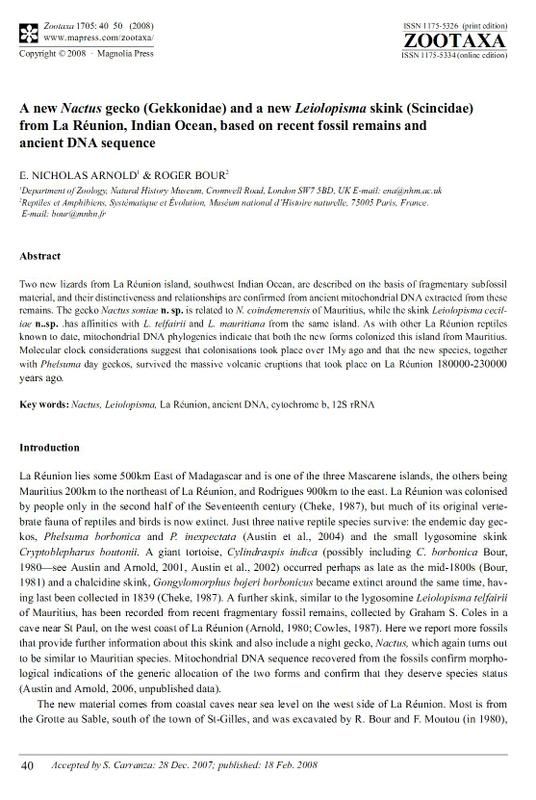|
|
Post by another specialist on Jun 20, 2008 19:10:22 GMT
 Here we report more fossils that provide further information about this skink and also include a night gecko, Nactus, which again turns out to be similar to Mauritian species. Mitochondrial DNA sequence recovered from the fossils confirm morphological indications of the generic allocation of the two forms and confirm that they deserve species status (Austin and Arnold, 2006, unpublished data). The new material comes from coastal caves near sea level on the west side of La Réunion. Most is from the Grotte au Sable, south of the town of St-Gilles, and was excavated by R. Bour and F. Moutou (in 1980), www.mapress.com/zootaxa/2008/f/z01705p050f.pdf |
|
|
|
Post by adzebill on Sept 9, 2008 23:06:04 GMT
Why this thread is not titled "Nactus soniae"?
|
|
|
|
Post by another specialist on Sept 10, 2008 5:49:49 GMT
Why this thread is not titled "Nactus soniae"? Will rename thread now |
|
|
|
Post by surroundx on Apr 26, 2018 11:54:31 GMT
|
|
|
|
Post by Melanie on Mar 29, 2020 22:17:34 GMT
Taxonomic Notes Justification Listed as Extinct on the basis that this species is known only from fragmentary subfossil remains. The date of its extinction is unknown, but may have been after 1500 AD. Geographic Range Information This species is known only from subfossil remains and DNA data collected from La Réunion (Arnold and Bour 2006). Population Information This species is known from fragmentary skull elements. No historical reports of this species exist, which is considered unsurprising for a small and inconspicuous gecko by Arnold and Bour (2008), and it is not known to be extant. Habitat and Ecology Information Nothing is known about the ecology of this species, but it was probably nocturnal (Arnold and Bour 2008). It is presumed to have been a coastal species (Probst 1996). Threats Information Nothing is known of the cause of this species' apparent extinction, although molecular clock data suggests that the species survived a "catastrophic" volcanic eruption on Réunion, 180,000-200,000 years ago (Arnold and Bour 2008). Arnold and Bour (2008) discuss the introduction of rats (first observed on Réunion in 1670 - Rattus rattus - and 1750 - R. norvegicus) in the context of the extinction of a larger lizard on the same island. As no historical records of this species exist, however, it is unknown whether the species was still extant when rats were introduced. Other species of Nactus are, however, known to have coexisted with rats and other mammalian predators in the Mascarenes, but to have suffered serious declines following the introduction of the invasive House Gecko Hemidactylus frenatus (Cole et al. 2005). Other predatory species introduced to the islands, including Wolf Snake (Lycodon aulicus) and Asian shrews, may also have been predators of this species if it was still extant when these animals were introduced. Use and Trade Information There is no use of or trade in this species, which is presumed to be extinct. Conservation Actions Information No conservation actions can be proposed for this species, as the species appears to be extinct. Three weeks of intensive surveys on Réunion in 2013 focused on skinks and Nactus geckos (M. Sanchez, C. Raxworthy, J.-M. Probst and S. Caceres unpubl. data) failed to record a surviving population, and it has not been found in a field survey of Petite Ile, an island close to the Réunion mainland from which both rats and house geckos are absent (M. Sanchez, J.-M. Probst and S. Caceres unpubl. data). www.iucnredlist.org/species/13484053/164136280 |
|